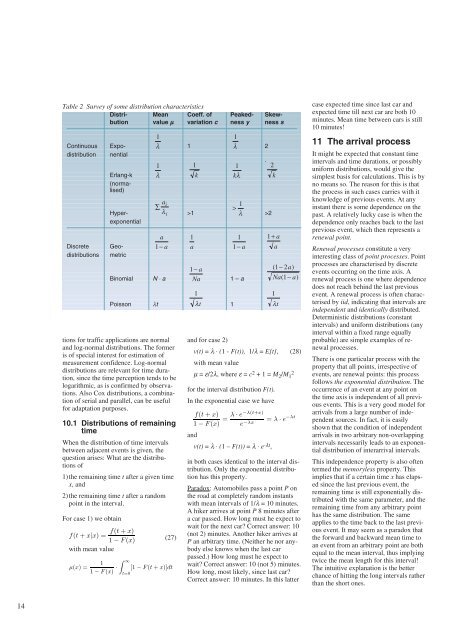Contents Telektronikk - Telenor
Contents Telektronikk - Telenor
Contents Telektronikk - Telenor
Create successful ePaper yourself
Turn your PDF publications into a flip-book with our unique Google optimized e-Paper software.
14<br />
Table 2 Survey of some distribution characteristics<br />
Distri- Mean Coeff. of Peaked- Skewbution<br />
value µµ variation c ness y ness s<br />
1<br />
1<br />
Continuous Expo- λ 1 λ 2<br />
distribution nential<br />
Erlang-k<br />
(normalised)<br />
Discrete Geodistributions<br />
metric<br />
tions for traffic applications are normal<br />
and log-normal distributions. The former<br />
is of special interest for estimation of<br />
measurement confidence. Log-normal<br />
distributions are relevant for time duration,<br />
since the time perception tends to be<br />
logarithmic, as is confirmed by observations.<br />
Also Cox distributions, a combination<br />
of serial and parallel, can be useful<br />
for adaptation purposes.<br />
10.1 Distributions of remaining<br />
time<br />
When the distribution of time intervals<br />
between adjacent events is given, the<br />
question arises: What are the distributions<br />
of<br />
1)the remaining time t after a given time<br />
x, and<br />
2)the remaining time t after a random<br />
point in the interval.<br />
For case 1) we obtain<br />
f(t + x)<br />
f(t + x|x) =<br />
1 − F (x)<br />
with mean value<br />
1<br />
λ<br />
Hyperexponential<br />
>1<br />
><br />
>2<br />
1<br />
ai ∑<br />
λi λ<br />
a<br />
1− a<br />
Binomial N ⋅ a<br />
1− a<br />
Na 1 – a<br />
Poisson λt λt 1<br />
(27)<br />
1<br />
µ(x) =<br />
1 − F (x) ·<br />
� ∞<br />
[1 − F (t + x)]dt<br />
t=0<br />
1<br />
k<br />
1<br />
a<br />
1<br />
1<br />
kλ<br />
1<br />
1− a<br />
2<br />
k<br />
and for case 2)<br />
v(t) = λ ⋅ (1 - F(t)), 1/λ = E{t}, (28)<br />
with mean value<br />
µ = ε/2λ, where ε = c2 + 1 = M2 /M 2<br />
1<br />
for the interval distribution F(t).<br />
In the exponential case we have<br />
and<br />
v(t) = λ ⋅ (1 – F(t)) = λ ⋅ e-λt ,<br />
1+ a<br />
a<br />
(1− 2a)<br />
Na(1− a)<br />
in both cases identical to the interval distribution.<br />
Only the exponential distribution<br />
has this property.<br />
Paradox: Automobiles pass a point P on<br />
the road at completely random instants<br />
with mean intervals of 1/λ = 10 minutes.<br />
A hiker arrives at point P 8 minutes after<br />
a car passed. How long must he expect to<br />
wait for the next car? Correct answer: 10<br />
(not 2) minutes. Another hiker arrives at<br />
P an arbitrary time. (Neither he nor anybody<br />
else knows when the last car<br />
passed.) How long must he expect to<br />
wait? Correct answer: 10 (not 5) minutes.<br />
How long, most likely, since last car?<br />
Correct answer: 10 minutes. In this latter<br />
1<br />
λt<br />
f(t + x) λ · e−λ(t+x)<br />
=<br />
1 − F (x) e−λx = λ · e −λt<br />
case expected time since last car and<br />
expected time till next car are both 10<br />
minutes. Mean time between cars is still<br />
10 minutes!<br />
11 The arrival process<br />
It might be expected that constant time<br />
intervals and time durations, or possibly<br />
uniform distributions, would give the<br />
simplest basis for calculations. This is by<br />
no means so. The reason for this is that<br />
the process in such cases carries with it<br />
knowledge of previous events. At any<br />
instant there is some dependence on the<br />
past. A relatively lucky case is when the<br />
dependence only reaches back to the last<br />
previous event, which then represents a<br />
renewal point.<br />
Renewal processes constitute a very<br />
interesting class of point processes. Point<br />
processes are characterised by discrete<br />
events occurring on the time axis. A<br />
renewal process is one where dependence<br />
does not reach behind the last previous<br />
event. A renewal process is often characterised<br />
by iid, indicating that intervals are<br />
independent and identically distributed.<br />
Deterministic distributions (constant<br />
intervals) and uniform distributions (any<br />
interval within a fixed range equally<br />
probable) are simple examples of renewal<br />
processes.<br />
There is one particular process with the<br />
property that all points, irrespective of<br />
events, are renewal points: this process<br />
follows the exponential distribution. The<br />
occurrence of an event at any point on<br />
the time axis is independent of all previous<br />
events. This is a very good model for<br />
arrivals from a large number of independent<br />
sources. In fact, it is easily<br />
shown that the condition of independent<br />
arrivals in two arbitrary non-overlapping<br />
intervals necessarily leads to an exponential<br />
distribution of interarrival intervals.<br />
This independence property is also often<br />
termed the memoryless property. This<br />
implies that if a certain time x has elapsed<br />
since the last previous event, the<br />
remaining time is still exponentially distributed<br />
with the same parameter, and the<br />
remaining time from any arbitrary point<br />
has the same distribution. The same<br />
applies to the time back to the last previous<br />
event. It may seem as a paradox that<br />
the forward and backward mean time to<br />
an event from an arbitrary point are both<br />
equal to the mean interval, thus implying<br />
twice the mean length for this interval!<br />
The intuitive explanation is the better<br />
chance of hitting the long intervals rather<br />
than the short ones.

















